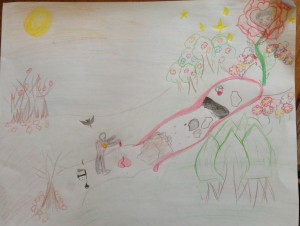Reading: De Bruijn “Persian Sufi Poetry”
One of the most important themes of mythical Persian poetry is Love. According to De Bruijn, the ghazal is the form of poetry that is the most “closely tied to the theme of love”, telling the story of a poet-lover expressing his feelings or looking desperately and usually vainly for his Beloved.
Ghazals are usually pervaded with symbols, notably involving Nature and the Animal Kingdom. Nature serves as a way to express and picture the Beloved’s beauty. The lover, the witness of the Beloved’s beauty (shahid), is usually in a blossoming Spring Garden that represent “an idealized world’, a sort of Paradise. It displays symbols that mirror the God’s grace. For instance, there are usually red flowers such as roses or tulips that remind the reader or listener of “blushing cheeks”, symbol of youth and beauty. The rest of the Natural world, such as the planets, the minerals, plants and animals also mirror Allah’s beauty. I tried to reflect that idea in my project by drawing a garden with flowers, trees, stars and the sun in the Sky. Yet, De Brujin underlines that the beauty of the garden is ephemeral so I displayed, behind the poet lover, automnal trees. De Bruijn sees this change in seasons as a parallel between both the “excitement” created by Spring followed by the “disillusionment stemming from the death of Nature” and the “union” followed by the “separation” between the Lover and the Beloved.
There are two especially important symbols that represent God and the poet: the rose and the nightingale. I have tried to incorporate them in my drawing according to the signification that they bear. The rose is a symbol of beauty and youth, so of the Beloved and the nightingale is seen as the poet-lover. It is common in Persian poetry for the Beloved not to be attributed a gender, but in many poems, he is incarnated in a young man, a “pisar” with black curly hair and with a beard. The beard has a double paradoxical signification: it evokes sadness, by marking the end of youth, but also desire as the pisar is at “the apex of its pristine beauty”. I incorporated these features in my representation of the Beloved by drawing the face of a young man on a rose.
Muhammad Ghazali argues that God has put in the human heart a “fire” that can be revived when getting closer to Him. The path to get closer to the Beloved is often difficult and rough (I placed rocks, holes and abysses on the road on my drawing). But the Lover is ready to brave any danger. He is completely intoxicated by his Love for God and forgets about rational thinking. This intoxication is symbolized through the metaphor of the wine: once drunk, one forgets about his identity, his selfishness and his logic. I represented two streams of wine flowing from the roses’ roots and we can see the poet-lover’s veins full of this delectable and forbidden poison.
I also represented behind the lover a broken scale: once drunk, he has no more sense of rationality and De Bruijn also argues that he cannot make the distinction between “good or bad, or belief and unbelief” as they “refer to values tinged by expectations of reward ad salvation that are concerned with the lover’s self interest” and thus do not concern the Beloved.

Recent Comments